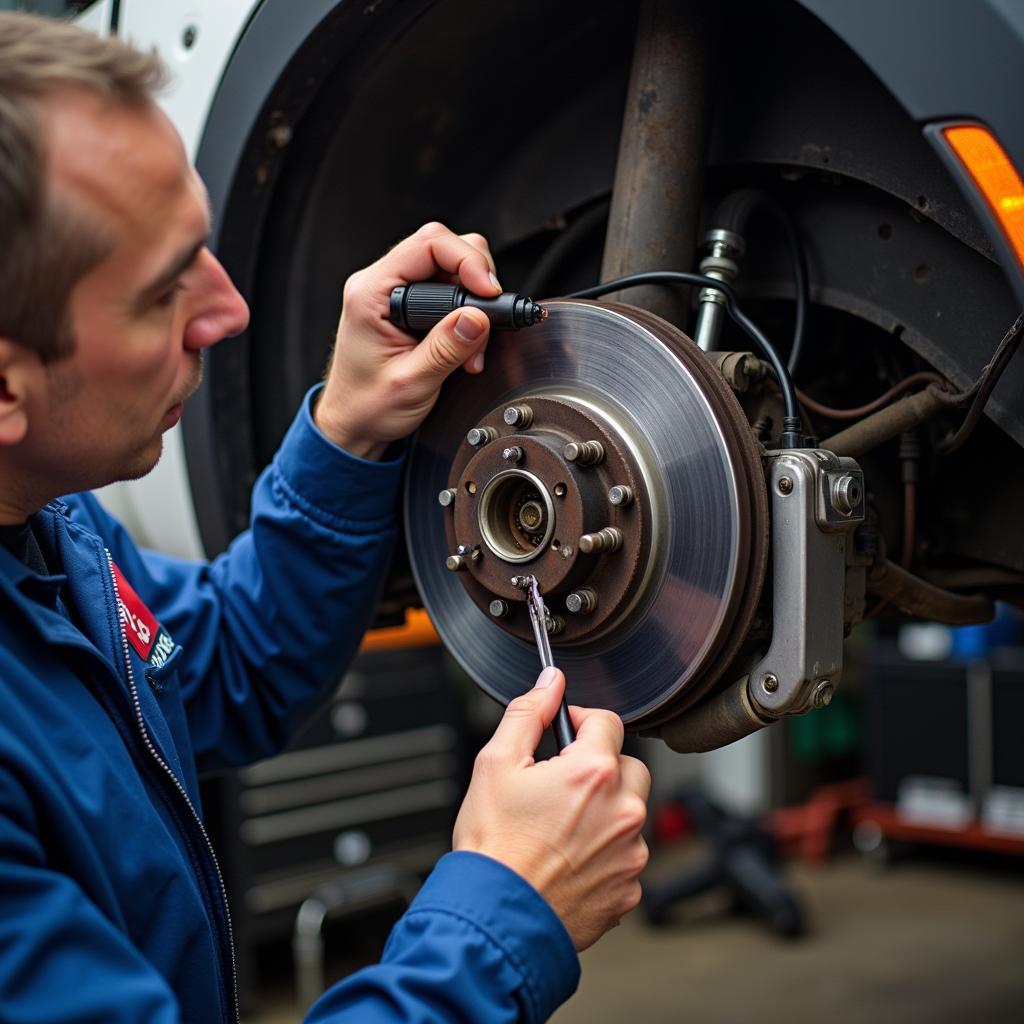The brake warning light on your Mini R56 illuminating can be a jarring experience. While it often signals a serious issue requiring immediate attention, it can sometimes be triggered by minor glitches or routine maintenance reminders. This comprehensive guide will delve into the common causes of the Mini R56 brake warning light, provide a step-by-step guide to reset it, and offer insights into when professional help is necessary.
Understanding the Mini R56 Brake Warning Light
The brake warning light on your Mini R56 is part of the vehicle’s electronic safety system, designed to alert you to potential issues with the braking system. When illuminated, it typically points to one of three main issues:
- Low brake fluid: Brake fluid is the lifeblood of your car’s braking system. A drop in fluid level often indicates a leak, which can severely compromise braking performance.
- Worn brake pads: Brake pads are designed to wear down over time. When they reach a certain thinness, the brake pad wear sensor triggers the warning light, reminding you to replace them.
- Malfunction in the braking system: This can range from a faulty sensor to issues with the ABS (Anti-lock Braking System) module. These situations often require professional diagnostics to pinpoint the exact problem.
Troubleshooting the Brake Warning Light
Before attempting to reset the brake warning light, it’s crucial to determine the root cause. Here’s a step-by-step guide:
- Check the brake fluid level: Park your Mini R56 on a level surface and locate the brake fluid reservoir. The reservoir will have a “Min” and “Max” marking on the side. If the fluid level is below the “Min” mark, add the appropriate brake fluid (consult your owner’s manual) to bring it to the “Max” mark.
- Inspect the brake pads: If the brake fluid level is adequate, the next step is to check the thickness of your brake pads. If they appear significantly worn down, it’s time for a replacement.
- Scan for fault codes: If both the brake fluid level and brake pads appear normal, a more complex issue might be at play. A diagnostic scan using a specialized OBD-II scanner can reveal specific fault codes stored in your car’s computer, providing valuable clues about the underlying problem.
Resetting the Brake Warning Light
Once you’ve addressed the root cause of the brake warning light, you can attempt to reset it. In many cases, simply fixing the underlying issue (e.g., refilling brake fluid or replacing brake pads) will automatically extinguish the warning light. However, if the light persists, you can try the following reset procedure:
- Turn the ignition key to the “on” position without starting the engine.
- Locate the brake pedal sensor switch, usually situated above the brake pedal arm.
- Press and release the brake pedal rapidly several times (around 10-15 times).
- Hold the brake pedal down for about 30 seconds.
- While still holding the brake pedal, turn the ignition key to the “off” position.
- Release the brake pedal and wait a few moments.
After completing these steps, turn the ignition key back to the “on” position. The brake warning light should be off. If the light remains on, it signifies a deeper issue requiring professional diagnosis and repair.
When to Consult a Professional
While this guide provides basic troubleshooting and reset instructions, it’s crucial to remember that working with your car’s braking system can be potentially dangerous. If you’re unsure about any step or the light persists after trying the reset procedure, seek professional assistance immediately.
Frequently Asked Questions (FAQs)
Q: Can I drive my Mini R56 with the brake warning light on?
A: Driving with an illuminated brake warning light can be extremely dangerous. It indicates a potential problem with your braking system that could lead to reduced braking performance or even complete brake failure. It’s crucial to address the issue immediately or have your vehicle towed to a qualified mechanic for inspection and repair.
Q: How often should I check my Mini R56’s brake fluid level?
A: It’s a good practice to check your brake fluid level at least once a month as part of your routine vehicle maintenance. This helps ensure the fluid level remains within a safe range and allows you to detect any potential leaks early on.
Q: How long do brake pads last on a Mini R56?
A: Brake pad lifespan varies greatly depending on driving style, road conditions, and pad material. However, as a general guideline, front brake pads typically last between 30,000 to 60,000 miles, while rear brake pads can last up to 80,000 miles. Regular inspection is key to determining when replacement is necessary.
Q: What is involved in a professional brake inspection?
A: A comprehensive brake inspection typically includes checking the brake fluid level and condition, inspecting brake pads and rotors for wear and damage, examining brake lines and hoses for leaks, and assessing the overall performance of the hydraulic system. This thorough check helps ensure the braking system is in optimal working order.
Q: What are some common signs of brake problems besides the warning light?
A: Apart from the illuminated warning light, other signs of potential brake issues include squealing or grinding noises when braking, a spongy or soft brake pedal feel, vibrations or pulsations in the brake pedal, pulling to one side while braking, and a burning smell coming from the brakes.
 A professional mechanic inspecting the braking system of a Mini R56.
A professional mechanic inspecting the braking system of a Mini R56.
Conclusion
Understanding the nuances of your Mini R56’s brake warning light is crucial for maintaining your safety on the road. While simple fixes like topping up brake fluid or resetting the light can be done at home, it’s paramount to err on the side of caution and seek professional help when in doubt. Remember, a well-maintained braking system is non-negotiable when it comes to your safety and the well-being of others on the road.

